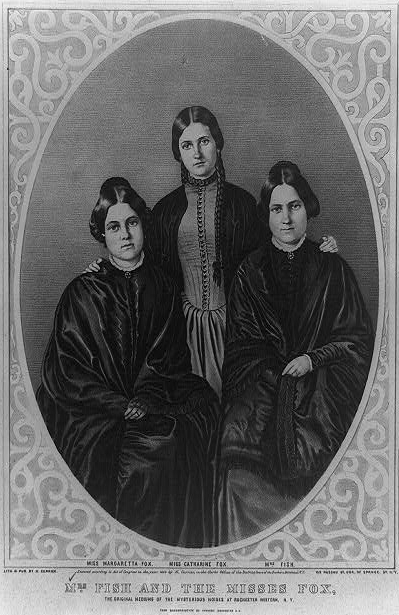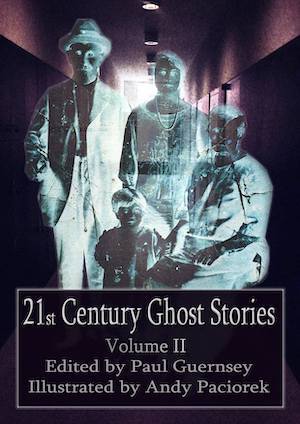
The Fox sisters—Kate (1838–92), Leah (1814–90), and Margaret (or Maggie) (1836–93)—were famous mediums in Rochester, New York who started the Spiritualist Movement.
When We Began Talking To Ghosts
Acording to the central belief of the religious and philosophical movement known as Spiritualism, not only is it possible to contact the spirits of the dead, but such contact can be beneficial, with the living receiving comfort, information, and advice from the departed. These communications frequently are exchanged through the intercession of facilitators known as mediums—people who have a special sensitivity for talking to, hearing, and even seeing spirits. Traditionally, spirits speak through a medium during a ceremony called a seance, which usually involves several people including the medium sitting around a table in the dark. However, contemporary mediums can give “spirit readings” in almost any setting, and people can even contact spirits on their own through such means as a Ouija board.
Spiritualism traces it roots to the Rochester area of upstate New York, where in 1848 three sisters, Kate (1838–92), Leah (1814–90), and Margaret (or Maggie) (1836–93) Fox, began claiming they could communicate with people who had died. Kate, the youngest Fox sister, was the most prominent medium of the three, and she allegedly received paranormal messages through coded knocks or “rappings” that she elicited from spirits during group sessions in houses that supposedly were haunted. These sessions—the first seances—became extremely popular, and soon a number of charismatic mediums including the Fox sisters were making a living traveling the country and helping people speak to the dead. By the early 1850s, seances had caught on in other English-speaking countries as well, especially in Britain, and the simple “table rappings” soon evolved into elaborate performances involving musical instruments that played by themselves and visible spirits who floated in the air.
In spite of many attempts to debunk the claims of mediums, Spiritualism thrived through and far beyond the Civil War years. By the late 1800s, Spiritualists were holding camp meetings and promoting such social causes as Women’s Suffrage. In 1888 the movement was damaged, though not destroyed, by the confessions of the Fox sisters that they had produced all their table rappings by making cracking sounds with the joints of their own legs, ankles, and toes. Further blows survived by Spiritualism included the definitive fraud exposures of a number of other high-profile mediums aside from the Foxes, as well as the invention (1890-91) and distribution of the Ouija board, which allowed people to perform free, do-it-yourself seances in their own homes.
By the turn of the 20th century, the informal Spiritualist Movement had begun to coalesce into a handful of interrelated churches that, in addition to promoting communication with the dead, held Sunday services featuring hymn singing and sermons on such themes as God and traditional Christian morality. Although interest in Spiritualism declined in the 1920s, Spiritualist churches still exist in the U.S., Britain, Canada, and throughout the English-speaking world, as well as in many other countries.
In the U.S., the core beliefs of the National Spiritualist Association of Churches are listed in the Association’s Declaration of Principles:
1. We believe in Infinite Intelligence.
2. We believe that the phenomena of Nature, both physical and spiritual, are the expression of Infinite Intelligence.
3. We affirm that a correct understanding of such expression and living in accordance therewith, constitute true religion.
4. We affirm that the existence and personal identity of the individual continue after the change called death.
5. We affirm that communication with the so-called dead is a fact, scientifically proven by the phenomena of Spiritualism.
6. We believe that the highest morality is contained in the Golden Rule: “Do unto others as you would have them do unto you.”
7. We affirm the moral responsibility of individuals, and that we make our own happiness or unhappiness as we obey or disobey Nature’s physical and spiritual laws.
8. We affirm that the doorway to reformation is never closed against any soul here or hereafter.
9. We affirm that the precepts of Prophecy and Healing are Divine attributes proven through Mediumship.”
Over Spiritualism’s nearly 170-year history, the most permanent and pervasive cultural change it has wrought undoubtedly would be our enduring popular interest in the notion of communicating with the spirits of the dead rather than invariably avoiding them and fleeing from them as people had done in the past. Of course, among people who believe such communication is possible, not everyone agrees it’s a good idea. . . .

